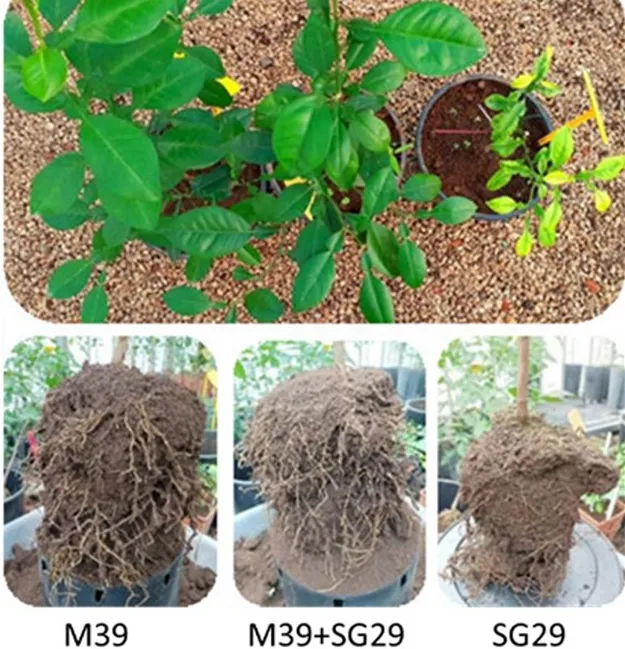The emergence of the Tristeza virus, introduced in the Mediterranean from Asian countries and transported by plants and propagating material to all continents, has caused enormous damage and has therefore made it necessary to prepare different defense tools compatible with the strains, soil and climatic conditions and aphid vectors.

Pictured above: The anti-CTV isolate from the SIRPA project (M39) causes no symptoms in experimentally inoculated bitter orange seedlings and protects them from infection with an aggressive isolate common in Sicily (SG29). When SG29 is inoculated into susceptible seedlings, there is significant yellowing, shortening of internodes and small leaves, and damage to the root system.
Almost all citrus producing countries have developed, adopted and shared appropriate diagnostic methods, propagating material certification programs and territorial phytosanitary surveillance. In addition, virus tolerant or resistant rootstocks have been introduced as an alternative to the bitter orange, which was once considered the savior of citrus cultivation due to its resistance to Phytophthora in the late 1860s.
In the Mediterranean area, certain strains of diseases cause vegetative decay, reduced yield and death of grafted plants on bitter orange trees. These rootstocks were selected based on their compatibility with the soil, climate and irrigation water of each location, as well as the cultivar that was to be grafted. However, some rootstocks have bio-agronomic limitations that have not yet been overcome by the bitter orange.
 Above: Bitter orange seedlings inoculated with an antiCTV isolate and challenged with an aggressive isolate for more than two years show no symptoms, while those that were unprotected and inoculated with the aggressive strain prevalent in Sicily died 12 months later (marked with the cross).
Above: Bitter orange seedlings inoculated with an antiCTV isolate and challenged with an aggressive isolate for more than two years show no symptoms, while those that were unprotected and inoculated with the aggressive strain prevalent in Sicily died 12 months later (marked with the cross).
Countries where virus strains that cause decline and poor production are found regardless of rootstock have addressed the situation with cross-protection (CP) methods, a type of vaccination of nursery stock that makes it tolerant to different virus isolates. Introduced in Brazil in the 1960s and regulated for decades, cross-protection has also been widely adopted in South Africa and Australia and is being studied in other countries.
Efforts to control the viral strains that cause the rapid deterioration of grafted orange plants in Mediterranean regions have yielded few results. However, in Sicily, researchers have been active and diligent. Over time, the University of Catania, CREA, and the Science and Technology Park have accumulated a wealth of knowledge and experience that forms the foundation for assessing methods to safeguard the bitter orange from viruses. It is a type of grafting that enables growth in areas with high levels of limestone, salinity, and humidity, which are not ideal for other rootstocks. Additionally, it has good tolerance to certain soil-borne diseases and pests.
Agrobiotech, a co-op of entrepreneurs and researchers with PhDs from the University of Catania, provided the idea for the PO FESR Sicily 2014-2020 measure 1.1.5. They've been working for almost a decade in the field of applied research for agriculture and the environment, specializing in the sustainable protection of Mediterranean and tropical crops. As the main partner in the SIRPA project 'Sustainable Biotechnologies for the Containment of Tristeza and Mal Secco of Citrus', Agrobiotech collaborated with CREA to tackle the problem of Tristeza and with the University to tackle Mal Secco.
Using new high-throughput sequencing (HTS) technologies, the researchers identified plants naturally infected with mild isolates of the virus in different areas of Sicily, characterized strains of the virus that cause no tristeza symptoms on bitter orange rootstock (no-SY), and used them in cross-protection trials against aggressive isolates of the virus prevalent in Italy and the Mediterranean.
After a decade of analysis and observations, recently published in the Viruses journal (https://www.mdpi.com/2504020), six no-SY isolates were found to possess genomic similarity to aggressive ones, providing protection against aggressive SY isolates. The differences between the six CP isolates and the three aggressive ones are limited to a few nucleotide variations in three CTV genes (p23, p33 and Orf1a). They create intricate mechanisms that prevent the occurrence of 'superinfection' by homologous isolates that are genetically similar to the protective isolates utilized as vaccines.
The results of the SIRPA project, based on a decade of research, indicate that CP has the potential to be a successful approach to block CTV infection in grafted bitter orange plants and that this method should be evaluated for possible use with other varieties in different countries.
 Pictured above are the founders of Agrobiotech - Giuseppe Scuderi, Marina Bazzano, and Marcella Russo. The authors of this publication include Grazia Licciardello from CREA, as well as Moshe Bar Joseph and Antonino Catara.
Pictured above are the founders of Agrobiotech - Giuseppe Scuderi, Marina Bazzano, and Marcella Russo. The authors of this publication include Grazia Licciardello from CREA, as well as Moshe Bar Joseph and Antonino Catara.
